
In my ley lines (for ghost hunting) research, I include this site because the story is so odd. And, it’s credible.
Ghosts, haunted places, and history
Case studies and ghost hunting tips for specific haunted locations.

In my ley lines (for ghost hunting) research, I include this site because the story is so odd. And, it’s credible.
For an unusual mix of ghosts, Ripon Prison in Yorkshire (England) stands alone. Here’s what to know before you go.
I became interested in Ripon’s ghosts when Most Haunted’s Season 19 took viewers into haunted Ripon Prison and Police Museum. It’s a compelling site.
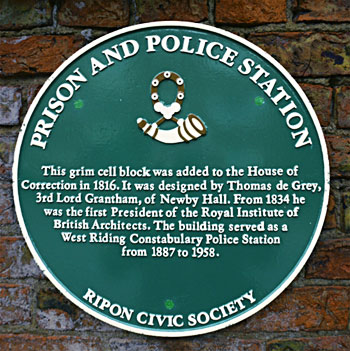 The Ripon Prison – originally known as Ripon Liberty Prison – dates back to the 17th century. The current building was the prison site from around 1816 – 1878.
The Ripon Prison – originally known as Ripon Liberty Prison – dates back to the 17th century. The current building was the prison site from around 1816 – 1878.
After the enactment of the Prison Act of 1877, the building was empty for about nine years. Then, it became the local police constabulary station through 1958.
It became a museum and visitor attraction around 1984. Today, it offers many opportunities for ghost hunters.
From my current research, no reported ghost has a specific name and history that can be verified.
Several researchers reported a spirit called “George.” (That seems to be a surprisingly popular name among British ghosts.) He’s described as a warder, not an inmate.
Note: When addressing prison ghosts, try using both “warder” and “warden.” The former is an older term and more popular in Britain, especially in connection with prisons.
However, warder’s secondary meaning (in history) includes “a truncheon or staff of office or authority, used in giving signals.” (ref. Dictionary.com) So, a warden might carry a warder, and a “watch out for the warder!” message might be more about an impending assault than a prison guard.
Another spirit is called Mary, Meg, or Margaret. She’s too young to have been a prisoner, unless she was there with her mother. (In past centuries, babies and very young children might be in a cell with their mothers, particularly if there was no one else to take care of the child.)
Always be cautious when a prison ghost claims to be very young. In some cases, the spirit is actually malicious. (Remember: Prisons held criminals.) That spirit may be hoping you’ll drop your guard/protection, and he (or she) can achieve viciously self-serving goals.
At Ripon Prison, something very dangerous – possibly not a ghost, but something much darker – might be loose.
One of the most useful triggers I’ve found in my research was the 2013 opening of an exhibit of photos of “lady prisoners,” at Ripon Prison.
Link: The wanted Victorian women: History mugshots reveal the cunning faces of England’s Nineteenth Century bad girls.
From my experiences, images of possible ghosts – especially unsavory men and women from the past – can leave an imprint. This can trigger a residual energy haunting, or even give the ghost a reason to actively haunt that location. (After all, people see him or her there.)
In the case of Ripon Prison, those photos may help investigators match ghostly figures and apparitions – as well as psychic impressions – to specific faces and names.
A casual survey suggests that Ripon Prison’s ghosts are an equal mix of prisoners and wardens or police officers.
That’s unusual.
In most prisons I’ve investigated, the ghosts were mostly prisoners or mostly wardens and guards, not in equal number.
Ripon Prison is the first haunted jail to break that rule.
If you’ve been to Ripon Prison and Police Museum, I hope you’ll leave a comment with your observations.
Note: Remember that many hauntings are related to extreme emotions and feelings.
So, at any prison, you may feel a mix of power and self-righteousness (wardens) or a wave of fear and sorrow (innocent or regret-filled prisoners).
You may get better results if you use questions that show admiration (for spirits reliving their glory days) or sympathy (for those unjustly jailed).
In-between, you might start with a comment like, “What great patience you’ve had.” Or, “Such forbearance!”
If you’re hoping to record some EVP, those kinds of comments might prompt responses from either a proud jailer or a miserable prisoner.
Ripon Prison and Police Museum seems very active and offers many kinds of ghostly encounters.
Most report:
However, since Ouija boards and dark rituals have been used at Ripon Prison – in recent years, and possibly while the building was empty – be sure to use strong spiritual protection for yourself and your team.
Also, before visiting Ripon Prison, research Thomas de Grey (1781–1859), 3rd Lord Grantham, the designer of the cell block. Sometimes, designers and architects leave their own imprint (or even revisit) sites they’ve built. That’s doubly true when the designer’s name is permanently visible on the building. (See the plaque in the photo, above.)
I’d also explore ghost stories and anomalies reported at Newby Hall, Grantham’s home, and look for connections. I’d especially look for references to “alchemy” associated with Newby Hall or Grantham.
Note: The most famous (or infamous) “ghost” of Newby Hall is from the 1963 photo by the Rev. F. K. Lord. To me, it looks like the photo was altered or it’s a double exposure. (Photo analysis in the 1960s wasn’t entirely reliable.)
Link: The Ghost of Newby Hall
However, the photo’s provenance prevents me from dismissing it altogether.
Here’s a short YouTube video that shows the Ripon Prison building. As an investigator, I note at the amount of metal (which can hold residual energy) and the age of this building. Also, all prison sites feature “trapped inside” and “you can’t leave here” cues.
To me, Ripon Prison and Police Museum looks like a great place for a ghost vigil… as long as you take adequate precautions, of course.
Is the ghost of Albert Williams real? Or was that a convenient fiction for a 2017 Most Haunted episode?
I expected the latter.
I was wrong.
When I watched the April 2017 “Most Haunted” episode filmed at the Slaughter House in Liverpool, I was intrigued.
Albert Williams is a name that Yvette received from spirit, during the investigation. According to Yvette’s impressions, Albert “looked after horses.” Around 1913, he may have been pushed down the Slaughter House stairs, and fell to his death.
Was he the same spirit in the “possibly 19th century” impression received by Billy in the earlier investigation?
Or, did two young men die there, in separate tragedies?
And was the searching (and probably distraught) mother Emma, not Meg or Mary? The names sound similar and could be confusing, especially if the psychic impression isn’t clear.
It’s too early to be certain.
Meanwhile, I was not optimistic about finding a likely Albert Williams. Williams is the third most popular surname in modern Britain, with nearly 300,000 people sharing the name.
Also, the given name of Albert – often a tribute to the memory of Queen Victoria’s husband – was very popular in that era.
I expected to find too many “Albert Williams” around Liverpool.
To my surprise, a likely match emerged early in my research. In fact, this was one of those times when the research seemed too easy.
Did he want me to confirm his identity? I can’t rule that out.
Here’s the most likely match for the Albert who contacted Yvette.
Albert Williams was born in 1900 in Liverpool, Lancashire, England, to Emma Graham, age 36, and Alfred Williams, age 40.
“Our” Albert Williams is shown in the following screenshot from the 1901 English census. I’ve circled his name on the census page. The family lived on Anglesea Road in the town of Liverpool. (Note that, in 1901, Albert’s father was a blacksmith.)
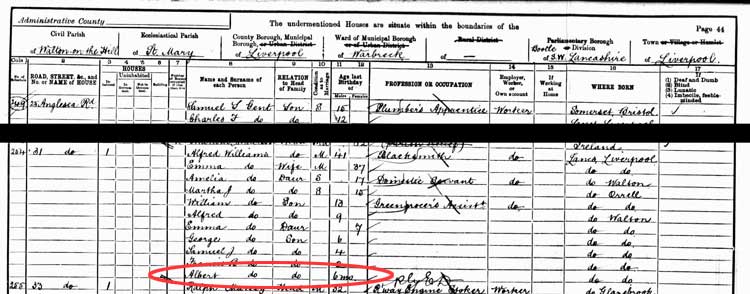
Next, here’s the 1911 census. (Again, I’ve circled “our” Albert Williams.)
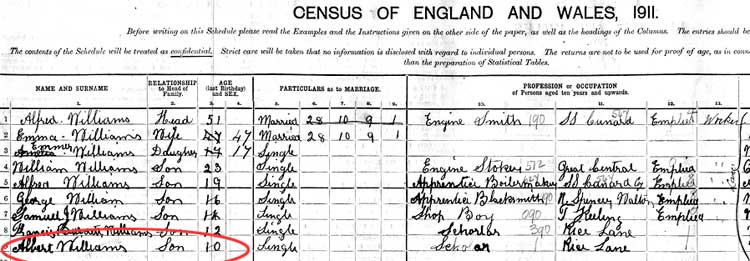
In 1911, Albert’s father was working as an Engine Smith (engineer) for the Cunard ship line.
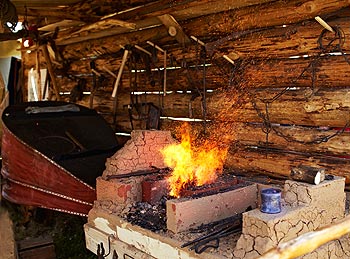
One of Albert’s older brothers, George, was an Apprentice Blacksmith.
(Remember, their father had been a blacksmith for most of his adult life.)
So, in 1913, it would be reasonable – in fact, likely – that young Albert (around age 12 or 13) might have “looked after horses” in Liverpool.
He might have worked in or near the Slaughter House location, too. It was a popular commercial area.
So, is this a match for young Albert who haunts the Slaughter House?
It’s more than likely. Here’s why.
I’ve found no records for this Albert Williams after 1911.
That suggests that he died young. Maybe as early as 1913.
Of course, there may be another explanation. Maybe I’d find this Albert Williams in later records, if I dug deeper.
Or, maybe this is the Albert Williams who died at the Slaughter House location around 1913… just as Yvette said.
That graphic links to the Amazon UK link. Click here for the Amazon US link.
Most Haunted may feature Todmorden Church in their fourth new episode (first airing 5 May 2017) in Season 19. (UPDATE: Yes, it was Todmorden Unitarian Church.)
So, I decided to research Todmorden’s ghosts, anticipating a chilling Most Haunted episode, when this one airs on Really (Fridays at 10 PM).
I wasn’t prepared for what I discovered about Todmorden.
You see… some sites offer scant historical evidence to support a long-term haunting.
I can spend weeks researching them, and find nothing weird, strange, or unusual. It’s all urban legends and fiction.
It has so many creepy and supernatural stories, I’m not sure where to begin. From bizarre crimes to UFOs, and from faeries to multiple hauntings, Todmorden offers more paranormal activity than most large cities I’ve investigated.
First, there are Todmorden’s many churches. Just one of them is the subject of the Most Haunted Season 19 episode.
According to Google, Todmorden’s churches include: Todmorden Unitarian Church, Central Methodist Church, St. Mary’s Church, Roomfield Baptist Church, Vale Baptist Church, St. Joseph’s RC Church, St. Michael’s Parish Church, and Walsden Methodist Church.
In addition, Todmorden features at least one former church, now privately owned.
Only a few of Todmorden’s churches – past and present – seem connected to ghost stories. Here’s what I found…
According to Wikipedia,
A double murder took place at Christ Church, Todmorden on 2 March 1868. The victims’ graves lie in the churchyard.
Miles Weatherhill, a 23-year-old weaver from the town, was forbidden from seeing his housemaid sweetheart, Sarah Bell, by the Reverend Anthony John Plow.
Armed with four pistols and an axe, Weatherhill took revenge first on the vicar and then on Jane Smith, another maid who had informed Plow of the secret meetings.
Miss Smith died at the scene, while the vicar survived another week before succumbing to his injuries.
Weatherhill also seriously injured the vicar’s wife.
Local legend has it that the face of a young woman is sometimes seen in the window of the vicarage, now in private ownership.
The full story (at Rootsweb) is even more tragic. Some of the photos (at a related Facebook page) from the site are impressive. And creepy.
From everything I’ve seen, that site looks like a great place to investigate… if you have permission, of course.
And then there are Todmorden’s Unitarian sites. They present lots of research possibilities.

The story of Todmorden’s Unitarian Church isn’t simple.
(That alone could make it an intriguing site for research.)
In fact, there were two Todmorden Unitarian Churches, both created by the wealthy Fielden family of Todmorden. (Their castle, Rossendale, is also supposed to be haunted.)
John Fielden (1784-1849) was the head of the family. He was a radical thinker, an MP, and a generous man.
In the 19th century, his family’s Waterside works – a cotton mill – became Todmorden’s major employer.
Fielden was also a Quaker who converted to Methodism. Later, he became one of the founding members of the local Methodist Unitarian Society.

When the early Methodist Unitarian community outgrew their meeting room at Hanging Ditch in Todmorden, Fielden helped to build a chapel and then he cleared the Society’s debt.
Today, he’s buried in a plain grave (with no headstone) in the yard next to that original chapel.
(If I were nearby, I’d definitely explore that site for EVP and photos. Sometimes those “no publicity, please” types are the same ones with a lot to say, in retrospect.)
In 1864, after John Fielden’s death, the congregation was large enough to need a full-sized church. So, John Fielden’s three sons built what’s now known as the Todmorden Unitarian Church on their land at Honey Hole in Todmorden.
(“Hanging Ditch” and “Honey Hole”…? Those names are so odd, they’d be unbelievable in fiction. But, in Todmorden, which translates to “death murder” – see below for details – I guess those names are normal. They certainly increase my interest in visiting the area.)
Then, after the new Unitarian church was completed, the old chapel became a Sunday School.
For a more complete history of the chapel, the church, and nearby burial grounds and memorials, see the church’s Rootsweb page.
Supporting history was at Shadows of the Night, which hosted vigils at the church. (That link vanished in May 2018, but – in case it returns – the URL was: http://www.shadowsofthenight.co.uk/todmorden-unitarian-church Meanwhile, it’s not at the Wayback Machine.)
The oldest Todmorden church, dating back to the 15th century, is currently holding services. It has a fascinating history, but no reported ghost stories. (Without specific ghost stories and research permission, I generally won’t investigate a church that’s currently in use.)
So far, everything I’ve found is vague, even at the two churches with ghost stories.
That combination – ghosts suggested, but few actual ghost stories – is odd, and even more strange in a community with such an extraordinary history.
I don’t want to say they’re hiding something, but… Really, this is extraordinary, even in the context of my “weird, as usual” research.
This church (and what looks like a neglected burial ground) seems to offer the most promise as a ghost hunting site, but I’m told that it’s privately owned. For that reason, I can’t recommend initiating ghost investigations there.
The only consistent story I’ve found is related to the spectral image of a murdered young woman. She’s probably the one in the story I quoted earlier (above).
Her face appears in windows, and I found a story about her – as a “figure in white” – fleeing her killer, and running through the burial yard. So, I’d start by observing the burial yard… from a safe and legal distance, of course.
As I explained above, this church (and related chapel) might be haunted. A few story elements indicate something paranormal. But, my research hasn’t turned up anything credible and concrete.
Putting the pieces together, from “a creepy feeling” to the sound of phantom footsteps, and from moving shadows to “the feeling you’re being watched,” it sounds like residual energy… but maybe shadow people (or “shadow figures”), too.
Some groups offer ghost vigils at this Todmorden church. Initially, I wasn’t interested in visiting. The lack of specific stories left me unimpressed.
But, with more research, I’m becoming more intrigued. (Understatement.)
For me, the tipping point was Rossendale, Todmorden Castle.
According to Haunted Rossendale, it was built by John Fielden, the son of the man who built Todmorden’s original Unitarian chapel. (John was also one of the brothers who built what’s now called the Todmorden Unitarian Church.)
From start to finish – including an unhappy marriage, a reclusive wife, and this John’s tragic accident that followed his second marriage – Todmorden Castle’s story is bizarre.
And then there’s John’s first wife’s unmarked grave at Todmorden Unitarian Church. I’d bet she has something to say, if you’re able to record EVP there.
In my opinion, if even half the Rossendale tale is true, it’s classic “ghost story” material, and powerful enough to bring the church into the eerie, paranormal loop.
So, my interest in Todmorden Unitarian Church leaped from “ho-hum” to “can’t wait to visit.”
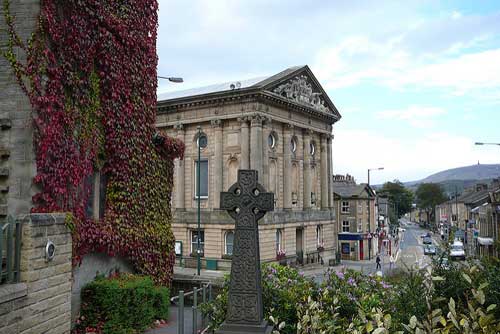
Todmorden is an odd, very German-sounding name. It also matches the profile of Names To Run Away From. (And The Week article about names with “mor” in them.)
When I heard that, in German, “tod morden” means “death murders,” I was sure it was a hoax.
It’s not (see for yourself). That’s odd. (And, if you know how I choose research site, you also know that “odd” is what interests me.)
However, as Todmorden residents insist, there’s more to that story.
There is a written record of the area in the Domesday Book (1086), and a 1610 map shows the name as Todmerden (see the red arrow on the map, below).
Earlier names included Tottemerden, Totmardene, and Totmereden, generally translated as “Totta’s valley” or – less likely – “marshy home of the fox.”
I’m not sure that completely dismisses the German translation. “Double meanings” can leave an energy impression on a site.
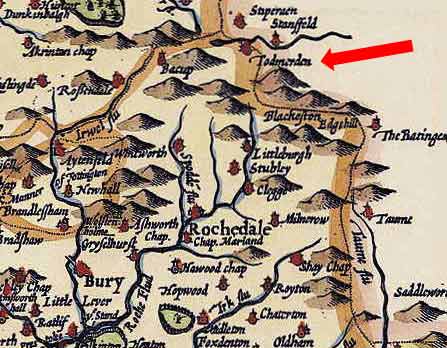
The Pagan history of the town includes Blackheath Barrow, a (possibly) Bronze Age ring cairn above Cross Stone in Todmorden. The four cairns were positioned at the north, east, south, and west points of the compass.
That’s unusual enough to interest me.
The earliest paranormal legend is attributed to the 17th century, when lady Sybil, heiress of Bearnshaw Tower (above Cornholme), sold her soul to gain supernatural powers. (A pot of gold may have been part of the deal, as well. It’s definitely part of the Bearnshaw Tower legend.)
That story has so much support, as well as unusual consistency in the telling, I’m intrigued.
But, when it comes to strange and eerie events, that’s the tip of the Todmorden iceberg.
The following are just a few more of Todmorden’s paranormal connections and stories.
And, for a fascinating urban exploration, see the documented visit to The Abandoned Auditorium of Todmorden.
If you’ve investigated Todmorden’s haunted places, I hope you’ll leave a comment, below.
Is Liverpool’s famous pub, The Slaughter House, truly haunted? And does history support its many ghost stories?
Here’s what I found out.
The haunted Slaughter House Pub is just one of many haunted sites in Liverpool.
It’s also the city’s oldest pub.
(The pub’s name gives me the creeps, but it’s popular with tourists as well as local residents.)
According to the Paranormal Database, the Slaughter House’s ghosts include two spirits who live in the cellar, and sometimes appear near the bar.
However, other reports suggest even more entities at the site.
So, let’s start with the obvious question… the pub’s name.
According to researcher Tom Slemen, the pub was never an “abbatoir” as some were called. (Other terms included “fleshers” and “flesh markets.”)
Mr. Slemen lists several previous owners and businesses at the Fenwick Street location.
I checked his research, and confirmed his results.
For example, I had no trouble finding Peter Edwards in the 1827 Liverpool city directory, with an office where the Slaughter House is, today. (His residence was 11 Portland Street. His office was 15 Fenwick Street.)
![]()
However, I’m not sure if Mr. Slemen studied anything before the late 18th century. (Generally, I like to go back at least to the 16th century, and as far back as the 14th – or earlier – if I can.)
Liverpool directories didn’t exist in earlier times, so it’s not an easy task.
So, Mr. Slemen’s initial study may not reflect the whole story. In fact, Alex of Auld City tours says the Slaughter House site was an abbatoir.
Until I can study this further, I’m reluctant to say it was never an abbatoir.
Note: English history goes much further back than modern records. Also, hauntings like the Slaughter House’s usually indicate a lengthy, turbulent past.
So, I cast a wide research net, and don’t rule out anything until I’ve triple-checked it.
If you’d like to dig further into history, see my preliminary notes about the Slaughter House site: Haunted History: The Slaughter House, Liverpool.
Reports at the pub include the sound of a little boy ghost, hair being moved by invisible fingers, other poltergeist activity, and the sound of glasses clinking when no one is nearby.
The best description of the Slaughter House’s ghosts appeared in a 2004 article, quoted at YO! Liverpool.
Here’s some of that article:
[from the cellar] …We decide to go walkabout. On the “evil” stairs leading out, the ghostometer begins to sound uncomfortable and Billy claims he feels a presence but nothing too strong and certainly not malevolent.
…We proceed to the top floor and it’s here, at the top of the stairwell, that Billy first detects something.
“The impression that I get here is that there was some kind of self destruction that somebody committed suicide. Somebody died in this area but it must have been some time ago. It was a man who hanged himself here.”
The ghostometer duly goes slightly bonkers emitting a fluctuating whine like that of the dentist’s drill. We head a little more quickly back downstairs where, back in the bar, it’s thought that it might be a good idea if Billy went back down in the cellar, alone this time, so as not to be distracted.
Billy, for some reason, doesn’t agree.
Minutes later Joe and I are perched on stools downstairs and after a brief surf with the divining rods – this area of the city apparently being awash with ley lines which convey psychic power – Billy has placed the ghostometer at the centre of the low stage at the far end of the room.
He then retreats to another stool on the far side where he sits occasionally stroking his chin apparently preoccupied in thought.
No words are spoken. The only sound is the warble of the ghostometer in mild distress.
Ten minutes later Billy springs up and walks over. “I’ve just been having a conversation,” he says calmly and then points at the stage.
“It’s a guy sitting over there. He says his name’s is Walter Langton. He worked here in the 1800s. He’s very rude and bad tempered and he says he wants to do me harm. I’ve told him he can’t. He chooses to be here. He also knows that we are here and he wants us to go. But I don’t feel intimidated.”
Billy then says that there is another presence on the stage. It’s a middle-aged woman dressed in grubby smock and bonnet. She’s possibly from the 19th century and called Meg or Mary. She’s unaware of us but is apparently looking for her son.
” He was crushed to death here,” adds Billy simply.
Needless to say neither Joe or I have seen or heard anything – it is, unfortunately, the drawback of the medium’s trade that concrete proof is hard to produce.
Nevertheless there’s an unnerving feeling that we’re not alone and there’s relief in finding the stairwell behind the bar – and not adjacent to Walter’s alleged spot at corner of the stage – to return to a curious Adam and co upstairs.
Because Liverpool was a very active port in the 1800s, it’s difficult to pinpoint just one likely person, even when the name is unusual.
Walter Langton might have worked at the site briefly, waiting for a ship to sail, or immediately after he arrived in England from Canada or the United States.
I found one Walter Langton, born around 1863 in Plymouth (England), who was part of the crew of a ship that docked regularly in Liverpool.
Casting a wider net, using “sound alikes” such as Langdon and Longton, I found a large array of Walters arriving and leaving on ships at the port.
A Walter Longton appeared in the 1871 census for Liverpool. He was a student and the son of a farmer. He was born around 1860. I have no further info about him.
My “gut feeling” is that the Slaughter House’s Walter Langton may have been a transient.
(For more history like this – strictly for hardcore researchers – see my related article, Haunted History: The Slaughter House, Liverpool.)
Between the size of Liverpool, it’s history as a busy port, rumored names (and myriad spellings), it’s difficult to confirm – or deny – the many stories connected to the Slaughter House and its ghosts.
My sense is: It’s haunted. I’m just not sure about the ghosts – who and how many, and from what eras.
Maybe the Slaughter House is just a convenient focal point for local urban legends.
But maybe it isn’t, and spirits really do lurk there.
If you’re going to be in Liverpool anyway, I think the Slaughter House pub is worth a visit, and definitely a ghost vigil.
Let me know what you discover. Something about the Slaughter House pub has an odd energy to it, and I’d like to understand what that is. It’s just… odd. That’s the only word to describe it.
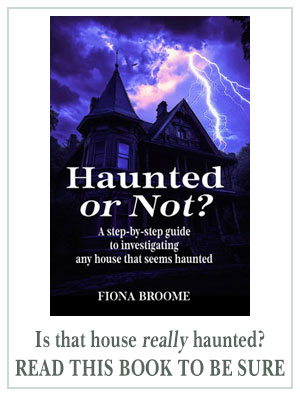 That graphic links to the Amazon UK link. Click here for the Amazon US link.
That graphic links to the Amazon UK link. Click here for the Amazon US link.
Here’s one YouTube video of an informal seance (glass on a table) at the Slaughter House:
 If you’re a ghost hunter interested in extremely detailed history related to the Slaughter House, here are more notes from my off-site research.
If you’re a ghost hunter interested in extremely detailed history related to the Slaughter House, here are more notes from my off-site research.
(If you’re looking for Slaughter House ghost stories, see my related article, Most Haunted: The Slaughter House, Liverpool.)
The following history might connect to ghosts in and near Liverpool’s Slaughter House.
First, I researched Jane Ellison. She was a previous owner of the Slaughter House site. I’m not sure those notes are useful.
Then, I studied old maps – and business directories – looking for local clues. That historical information may be helpful for future investigations at the Slaughter House.
Or it might be irrelevant. I haven’t a clue, but – having put so much time into this – I’m sharing it in case it’s useful.
Using Tom Slemen’s list of historical owners of the haunted Slaughter House site, I researched early owner Jane Ellison.
For some reason, Jane’s name seems to “light up” for me. (When I use that expression, it means the item seemed to hold my attention more than it should. That’s when I go looking for something odd to explain it.)
Jane Ellison #1
Here’s one interesting Jane Ellison, but I don’t know if she had any connection to the history of the Slaughter House.
This Jane Ellison was born about 7 March 1820 as a “female bastard” child of James Ellison, a laborer (from the nearby borough of Knowsley), and a woman whose name might be Margaret, but I can’t quite read it.
Here’s part of the court record:
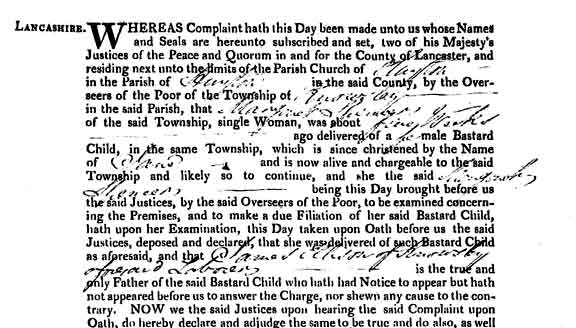
However, Ellison isn’t an unusual name in England.
This document does tell us that, in the early 1800s, at least one Liverpool-area Ellison caused some drama. He didn’t show up at court when charged as Jane’s father.
That’s a big red flag, if this Jane Ellison was connected with the history of the Slaughter House.
Also, in the 1766 directory, I found only one Ellison actually in Liverpool. (He was David Ellison, a watch maker on Ranelagh Street, not far from the Slaughter House site.)
So, maybe “Ellison” wasn’t a popular surname in the area, until much later.
Jane Ellison #2
Next, I found a burial record for “Jane, daughter of Jane Ellison,” who was buried 4 Oct 1819 in Liverpool.
The oddity there is that she’s just the “Jane, daughter of Jane Ellison,” without a father listed. Other entries on the same page list the mother and father of each deceased person.
Here’s the burial record:

Below, you can read the detail.
![]()
That record shows:
So, there are two red flags connected with the name “Jane Ellison.” One was an illegitimate child, Jane Ellison, who was born in 1820.
The second (but lesser anomaly) was another Jane Ellison who appears to be a single parent, and – in 1819 – she buried a child named Jane Ellison.
In my research, I always note those kinds of anomalies. At least half the time, if they’re connected to a haunted site, their stories will be related to that site’s ghostly energy.
(Additional — but less unusual — Jane Ellison notes are at the foot of this article.)
Next, I looked at Liverpool maps and city directories. If I were investigating at the Slaughter House, I’d definitely study the maps in greater detail. I’m sure more clues are hidden in the history of the neighborhood.
If you’re researching the haunted Slaughter House’s history, here’s how the immediate area looked in 1766 Gore’s Liverpool Directory. (That directory is available, online.)
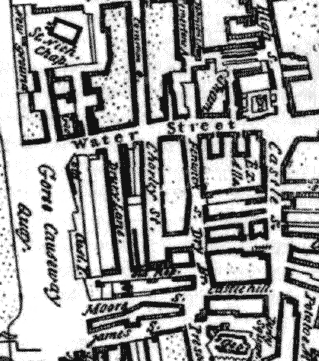
Here’s a transparent overlay of the current Slaughter House site (courtesy Google Maps), on that 1766 map.
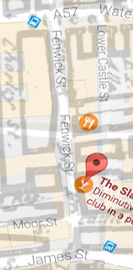
So, if you’re studying what was where in the late 18th century, the green arrow, on the map below, points to the current Slaughter House site.
I’m not sure what the “Dry Bn” was, or if that’s what the map says. But, I’d look at the history of the area where Fenwick Street (circled in red) intersected with Moore Street and — on the 1766 map — what’s indicated as Castle hill.
I’d also look at what was on Castle Street, in or close to the same building.
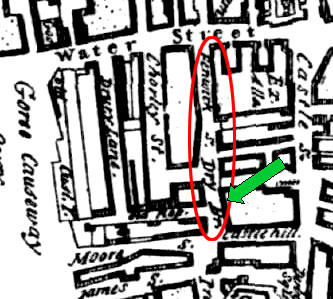
In 1766, these were businesses on or near Fenwick Street:
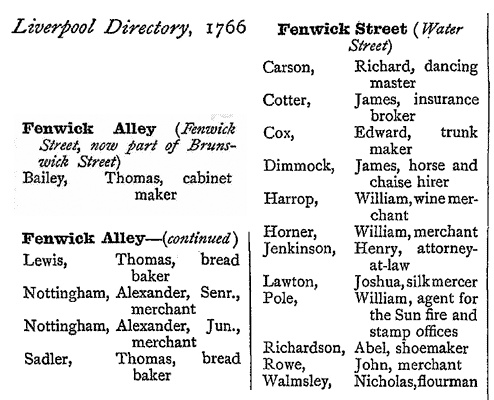
“Peter Carson, dancing-master” caught my attention. From my previous research involving dancing-masters, he’s likely to have a colorful history. (But, to be fair, “dancing-master” didn’t always indicate something other than dancing lessons.)
Other directory notes
Surveying the area, I have an uneasy feeling about nearby Castle Street, where a “cabinetmaker and toyman” business was mentioned. Perhaps something there was connected to the Slaughter House’s ghost stories.
And, Thomas Banner was an innkeeper at the Golden Fleece on nearby Dale Street. It was a long street, so that may not be near the Slaughter House site. It simply caught my attention as I was studying the area. (Also on that street, an inn called the Golden Lion. Interesting juxtaposition of names, particularly if they were near one another.)
Note: Every “Golden Fleece” I’ve researched has had more ghost stories than average. One usually involves a man chasing a woman as she fled for her life. Some of those tales ended more happily than others.
If you find more useful history related to the Slaughter House ghosts, let me know in comments, below.
Slaughter House photo courtesy Rodhullandemu
![]()
I’m including the following notes about Jane Ellison of Liverpool, for dedicated researchers who may find them useful. At this point, these Jane Ellisons don’t necessarily connect to the history of the Slaughter House or its ghosts.
Jane Ellison #3
This is not unusual; I’m including it in case it’s pertinent, later.
A Jane Ellison, age 75, was buried on 24 Jan 1838. (Born around 1763.) She died in the workhouse.
Aside from living to a grand old age (for that era), and the sadness of dying in a workhouse on a cold January day, there’s nothing of note in this. But, she could have been the surviving Jane Ellison #2 (above).
![]()
Jane Ellison #4
I’m not sure this has anything to do with the Slaughter House, either, but I found the “Will of Jane Ellison, Spinster” in Liverpool. (Reading it requires a fee, and I’m not that interested… yet.)
Note: If she is related to history of the Slaughter House, I’d read that will. Wills and probate records sometimes include the oddest details that can shed light on paranormal activity.
Jane Ellison #5
Here’s the marriage record of another Jane Ellison. Nothing odd here, but it may be useful, later.
Marriage: 26 Oct 1871 St Michael in the Hamlet, Aigburth, Lancs. (in Liverpool)
Joseph Craven – 25 Mariner Bachelor of St James Place
Jane Ellison – 22 Spinster of Collins St
Groom’s Father: William Craven, Builder
Bride’s Father: John Ellison, Labourer
Witness: Thomas Craven; Mary Ann Ellison
 That graphic links to the Amazon UK link. Click here for the Amazon US link.
That graphic links to the Amazon UK link. Click here for the Amazon US link.